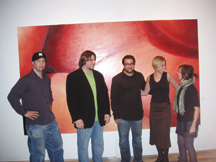Once upon a time, Hoboken had an art scene. These days, artists in town are struggling to pay high rents, but a select few are throwing up their arms and proclaiming that art will live.
For some, the palette is bleak, mostly gray. Along the southern edge of town, the former Neumann Leathers factory complex, one of the last bastions of affordable artist work space, narrowly escaped extinction at the hands of a development firm last year. It was saved by one vote at the Zoning Board of Adjustments, but may still be in the sights of developers.
In the northwest, the Monroe Arts Center is staring down bankruptcy. Its future remains uncertain.
“We present the human form in a spiritual way.” – Matthew Lahm
________
The intention of the redevelopment zone is to encourage developers to build in blighted areas, but the council’s main intent is to create a park in the area. Nonetheless, photographer and gallery owner Paul Vincent trudged ahead in the name of art.
Created gallery from nothing
Vincent, from Paterson, has been a photographer for 18 years and has lived in Hoboken for the last nine years.
His portion of the old warehouse began as one big open room with 2,000 square feet of blank space, which he converted into three separate rooms that he uses for gallery sections or rents out for photo shoots.
“I built everything, track lighting, everything,” he said. “I’m trying to get the arts back in Hoboken.”
The location is very accessible. He said that it is close to the PATH trains and the Holland Tunnel, and parking isn’t that bad.
There’s also a courtyard in the back that they have used for video shoots.
The warehouse is home to a wallpaper company, a recording studio on the third floor for the local band El Nino, a leather maker, and a lot of artists, like twin brothers River and Ocean Clark, photographer and pop artist, respectively.
Vincent is working with curator Tara Thurber and photographer Virginia Kamenitzer to spread the word about the studio/gallery.
Body as evidence
Artists Matthew Lahm and William Coronado are gambling that Vincent’s bet will pay off. Their exhibit of flesh and body art, a “figurative art” show depicting different body-based paintings and a video, runs in the gallery until Saturday, Dec. 5.
Lahm lives in Weehawken, but is from Livingston, while Coronado is from Weehawken and West New York, but lives in Passaic. The two have paired for shows before, having met as undergrads at New Jersey City University in 1999.
“That’s when we started this conversation,” Lahm said.
“And it never ended,” Coronado added.
Lahm said their art flies in the face of the “masses in tune to a TV world.” It reintroduces flesh and body to these “digital” creatures with a “forgotten identity.”
“We present the human form in a spiritual way,” Lahm said. His work, he said, deals with “alienation and intimacy at the same time.”
Lahm is preparing for a month-long solo show in Rome, offered after a gallerist saw a book featuring his collection.
He’s Italian and his wife is from Rome, so, “We have roots there.”
Not only family roots, but his artistic roots come from Italy as well. Both Lahm and Coronado acknowledge their classical and romantic inclinations with a nod to Caravaggio, Vasquez, and Goya. Goya was the last link to the Old Masters and the first link to modernism.
“This is the body as a language signal,” Lahm said of his flesh-in-nebulous-positions compositions.
“I’m always asked how I arrived at the positions,” he said. “I don’t know.”
He uses live models to create his indescribable images. Is it the nook of an elbow or the crease of a shoulder blade? Or something much different?
His intention, he said, is to “remove identity” and “focus more on the humanity issue.”
“People bring assumptions,” he said. “Name and object have no fundamental connection. [I want people to] perceive ‘body’ without constraints on ‘arm,’ or ‘breast,’ or ‘stomach.’”
Undermining logic
Coronado’s video composition “Talking Body Parts” is comprised of interviews that are presented visually with only eyes, mouth, and other body parts, disjoined on screen.
“It’s more emotional, more primitive than logical,” Coronado said.
Some of his paintings are oil on cut-out canvas, arranged on the wall showing different body parts and levels of human biology – cells, sperm, feces, intestines – juxtaposed with a full human form.
“They’re off the wall, part of architecture,” he said of the paintings. “Not constrained with a rectangle.”
“Our notion of figures changes, alters with changes in science,” he said. “This is figurative science distorted.”
Figurative science, he said, in the way that textbooks depict a human cell, is a completely fantastical representation of real biology.
But flesh, they agree, is a theme that goes beyond biology. Skin is nothing but “layers that we insulate ourselves in,” Lahm said, like many other emotional and intellectual layers.
Lahm, who is also a musician, works in administration at NJCU, while Coronado spends his days at the Cicely Tyson Performing and Visual Arts School in East Orange.
Of the gallery, Cornado said, “It’s a relatively new gallery, but great things are happening here.”
“There’s this notion of grand art in New York City, but the emerging artist scene is slowing down,” he said. “It’s a good time for new artists.”
For more information about Paul Vincent Studios, visit paulvincentstudios.com.
For more information on Matthew Lahm, visit matthewlahmart.com; for William Coronado, visit williamcoronado.com.
Timothy J. Carroll may be reached at tcarroll@hudsonreporter.com.
